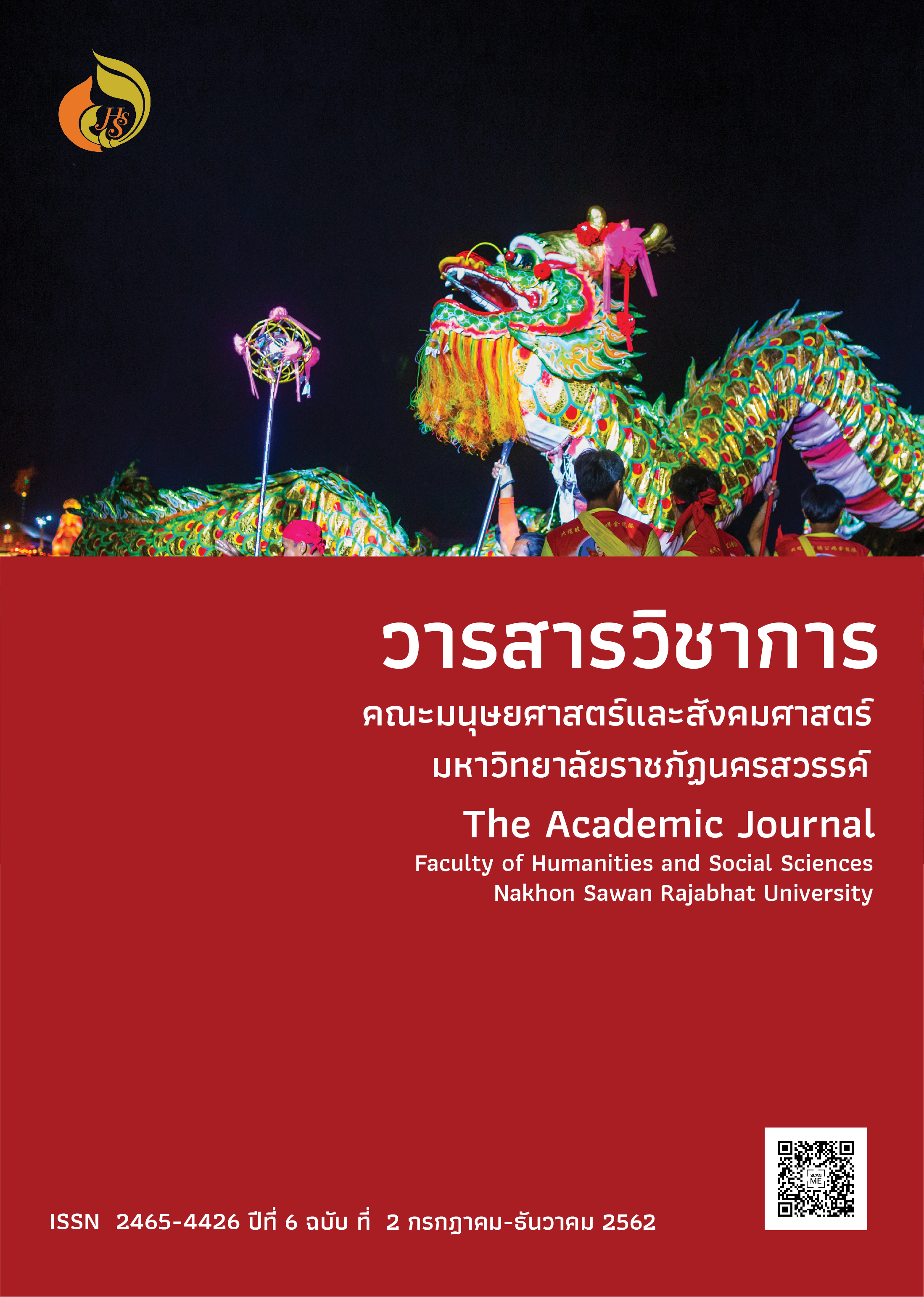Identity Construction of Southern Thai People Through Shadow Play
Main Article Content
Abstract
The objectives of this research were to study 1) the prevailing identity of southern Thais in the Songkhla Lake Basin region; 2) tactics in which the identity of southern Thais is constructed via the folk medium of shadow plays; and 3) shadow play viewers’ signification of the meaning of southern Thai people. This was a qualitative research based on documentary research, analysis of shadow play scripts, in-depth interviews and focus group discussions. The key informants came from 3 groups: 1) conservative shadow play troupes, represented by master Rungwichien Talungsiangtong; 2) mixed shadow play troupes, represented by master Naeb Nualjan Sor Nakarin; and 3) modern shadow play troupes, represented by master Iadnuy Sor Klaonoy. The other 9 purposively selected samples represented 3 kinds of audience members: regular shadow play fans, occasional watchers, and popular trend followers. The research tools were a document analysis form, a shadow play script analysis form, an in-depth interview form and a focus group discussion form. Data were analyzed through descriptive analysis.
The results showed that 1) for the prevailing identity of southern Thais in the Songkhla Lake Basin region, (a) they inhabit mountains, forests, fields, and the sea; the climate consists of a rainy season and a hot season with local wind patterns; and they live in houses raised on stilts; (b) the people are Buddist, Muslim and Thai of Chinese descent ,are dark-skinned with curly hair and dark eyes, strong and slight figures, and sharp chins; their characters are grateful, honorable, good at negotiating and loyal to their group; they tend to wear traditional sarongs made of homespun cotton; they are farmers, fishermen and tradesmen; they speak particular local dialects; they eat spicy foods made from local ingredients with condiments; and (c) their worldview is influenced by beliefs about religion and the supernatural; and they practice customs based on their way of life and beliefs. 2) As for tactics in which the identity of southern Thais is constructed via shadow plays, shadow play performers use the Western method of storytelling and also tactics specific to the shadow play art form that are based on local traditions. The identity of southern Thais encoded in shadow play performances consists of (a) their habitation, both supernatural and in real life; (b) individuals who are superhuman, high class and common folk; (c) a world view with belief in the supernatural, respect for the sacred and for teachers, valuing good deeds, mercy, obedience and nationalism; 3) shadow play viewers’ signification of the meaning of southern Thai people (a) habitations were in imaginary scenes and in real life places; (b) characters represented superhuman figures, high class people and common folk; (c) the worldview was transmitted through belief in sacred rituals and southern Thai art and culture; (d) negotiating, defiance and acceptance as viewers accepted the individual identity of southern Thai people as represented by the clown character in the shadow play because of his style of dress, personality, language, culinary style, and occupation, which matched the southern Thai identity that prevailed in the locality and that was portrayed in shadow play performances
Article Details
References
กำจร หลุยยะพงศ์. (2551). อัตลักษณ์และความสามารถทางการสื่อสารของแกนนำชมรมผู้สูงอายุ
ต.โพธิ์ไทรงาม จ.พิจิตร ในการทำกิจกรรมเพื่อพัฒนาตนเองและชุมชน. กรุงเทพฯ: สำนักงานคณะกรรมการวัฒนธรรมแห่งชาติ กระทรวงวัฒนธรรม.
ชวน เพชรแก้ว. (2548). หนังตะลุงในประเทศไทย. สุราษฎร์ธานี: สำนักศิลปะและวัฒนธรรมมหาวิทยาลัยราชภัฏสุราษฎร์ธานี.
ณฐพงศ์ จิตรนิรัตน์. (2548). อัตลักษณ์ชุมชนภาคใต้: บทสำรวจเบื้องต้นจากเอกสาร. วารสารปาริชาติ, 18(1), 102-117.
นิติ ภวัครพันธุ์. (2541). บางครั้งเป็นคนไทย บางครั้งไม่ใช่ อัตลักษณ์แห่งตัวตนที่ผันแปรได้.
รัฐศาสตร์สาร, 20(3), 215-252.
ปรีดา นัคเร. (2549). แนวทางการส่งเสริมหนังตะลุงสำหรับกลุ่มผู้รับสารวัยรุ่นในจังหวัดสงขลา (วิทยานิพนธ์วารสารศาสตรมหาบัณฑิต). กรุงเทพฯ: คณะวารสารศาสตร์และสื่อสารมวลชนมหาวิทยาลัยธรรมศาสตร์.
พิทยา บุษรารัตน์. (2553). การแสดงพื้นบ้าน : การเปลี่ยนแปลงและความสัมพันธ์กับสังคมและวัฒนธรรม บริเวณลุ่มทะเลสาบสงขลา กรณีศึกษาหนังตะลุงและโนรา ช่วงการปฏิรูปการปกครองสมัย รัชกาลที่ 5- ปัจจุบัน. กรุงเทพฯ: สำนักงานกองทุนสนับสนุนการวิจัย.
________ . (2547). หนังตะลุงและโนราในบริบทของโครงสร้าง และพลวัตทางสังคมวัฒนธรรมภาคใต้.วารสารทักษิณคดี, 7(1), 107-138.
ภริตพร สุขโกศล. (2548). การสืบทอดอัตลักษณ์ของชาวใต้ผ่านหนังตะลุง. พิษณุโลก: คณะวิทยาการจัดการและสารสนเทศศาสตร์. มหาวิทยาลัยนเรศวร.
วิมลมาศ ปฤชากุล. (2550). อัตลักษณ์พื้นถิ่นในบันเทิงคดีภาคใต้ (วิทยานิพนธ์อักษรศาสตรดุษฎีบัณฑิต). กรุงเทพฯ: จุฬาลงกรณ์มหาวิทยาลัย,
สมสุข หินวิมาน. (2548). ทฤษฎีสำนักวัฒนธรรมศึกษา. ใน ประมวลสาระชุดวิชาปรัชญานิเทศศาสตร์และทฤษฎีการสื่อสาร หน่วยที่ 13. นนทบุรี: สำนักพิมพ์มหาวิทยาลัยสุโขทัยธรรมาธิราช.
________ . (2548). สื่อพื้นบ้านสื่อสารสุข : แนวคิดและความหมาย. ใน ปรารถนา จันทรพันธุ์ (บก.). สื่อพื้นบ้านสื่อสารสุข.โครงการสื่อพื้นบ้าน เพื่อการสร้างเสริมสุขภาพชุมชน (สพส.). หน้า 30-31. กรุงเทพฯ : โรงพิมพ์มหาวิทยาลัยธรรมศาสตร์.
อภิญญา เฟื่องฟู. (2546). อัตลักษณ์: การทบทวนทฤษฎีและกรอบแนวคิด. กรุงเทพฯ: คณะกรรมการ
สภาวิจัยแห่งชาติ สาขาสังคมวิทยา สำนักงานคณะกรรมการวิจัยแห่งชาติ.
อาคม เดชทองคำ. (2543). หัวเชือกวัวชน. กรุงเทพฯ: สำนักงานกองทุนสนับสนุนการวิจัย.
Barker, C. (2008). Cultural Studies. London: Sage.
Clifford Geertz. (1983). Local Knowledge. New York: Basic Books.
Hall S. (1997). Representation: Cultural Representations and Signify Practices. London: Sage.
Woodward, K. (1997). Identity and difference. London: Sage.
Woodward, K. (2002). Understanding Identity. London: Sage.


